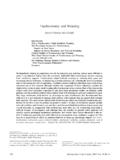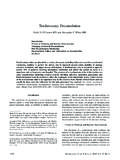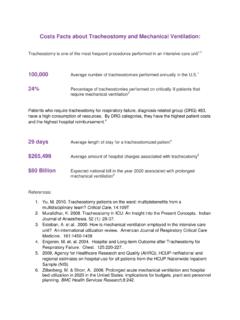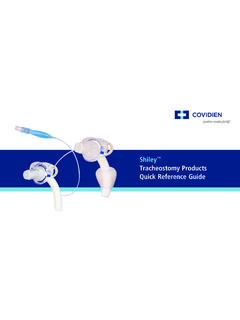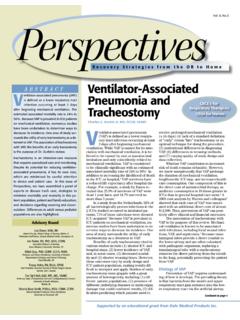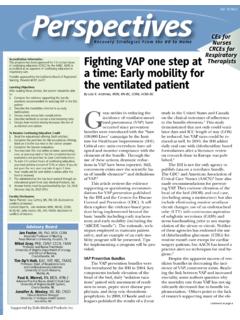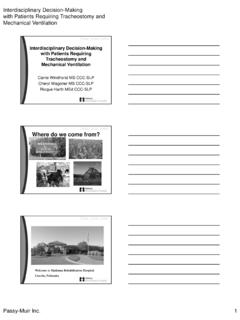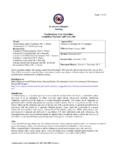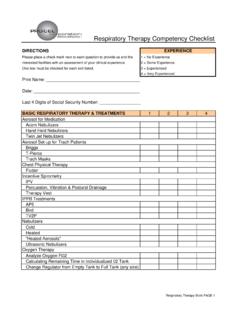Transcription of Tracheostomy care guidelines - Portale …
1 Tracheostomy care guidelines Nepean Hospital April 2005. Third draft Developed by Hailey Carpen, ICU Liaison CNC, April 2005. TABLE OF CONTENTS. Tracheostomy care guidelines ..3. Types of Tracheostomy ..3. Types of Tracheostomy Types Of Tracheostomy Tubes Used In Nepean Components Of A Tracheostomy Tube ..7. Bedside Immediate Post Operative Potential General guidelines for the care of Patient with a Tracheostomy ..13. guidelines for Tracheal Suctioning ..16. guidelines for Changing a Tracheostomy care Of Passy Muir Speaking References ..32. Final draft May 2005 2. C:\Documents and Settings\stronga\Desktop\ Tracheostomy care guidelines Description A Tracheostomy is the formation of an opening into the trachea usually between the second and third rings of cartilage. Indications for Tracheostomy o Facilitate weaning from mechanical ventilation by decreasing anatomical dead space. o Prevention / treatment of retained tracheo-bronchial secretions. o Chronic upper airway obstruction o Bypass acute upper airway obstruction Types of Tracheostomy The Tracheostomy may be temporary or long term, and may be formed electively or as an emergency procedure.
2 A temporary Tracheostomy can be formed when patients require long term respiratory support or are unable to protect their own airways. A Tracheostomy tube will be inserted to maintain the patency of the airway. This can be removed when the patient recovers. A temporary Tracheostomy may become long term if the patient's condition requires this. A permanent Tracheostomy is created where the trachea is brought out to the surface of the skin and sutured to the neck wall. This stoma is kept open by the rigidity of the tracheal cartilage. The patient will breathe through this stoma for the remainder of his/her life. As a result, there is no connection between the nasal passages and the trachea. This procedure is elective and the patients need to be carefully prepared for the consequences of the procedure. Final draft May 2005 3. C:\Documents and Settings\stronga\Desktop\ Features of Tracheostomy Tubes Tracheostomy tubes have different features depending on their intended use.
3 There are a large variety of tubes available which provide some or all of these features. Introducers All Tracheostomy tubes should be inserted using an introducer to prevent damaging the trachea during insertion of the tube. Once the Tracheostomy tube has been inserted the introducer should be disposed of. Cuffs Some Tracheostomy tubes have a cuff which, when inflated, provides an airtight seal which facilitates artificial ventilation. Inner tubes Tracheostomy tubes with inner tubes consist of an outer tube, which remains insitu, through which a smaller, inner tube is inserted. The inner tube has an extension at its upper aspect that can be connected to other equipment. It can be removed for cleaning and when weaning the patient. A replacement non-fenestrated inner tube must be kept at the patients bedside at all times. Fenestrations Fenestrated Tracheostomy tubes have a fenestration (hole) in the middle of the upper aspect of the tube. This will allow the passage of air and secretions into the mouth and nose in the normal way rather than directing them out via the Tracheostomy tube.
4 These tubes will always have a non- fenestrated inner tube, which must be inserted if the patient requires further respiratory support or suctioning so the catheter does not pass through the fenestration instead of into the airway. Sub glottic suction Blue Line Tracheostomy tube from Portex will allow suctioning of the airway above the cuff. This feature will allow the user to remove excessive upper airway secretions that could accumulate above the cuff and flow through the stoma. Intermittent suctioning via this outlet has been shown to decrease the incidence of ventilator-associated pneumonia. Final draft May 2005 4. C:\Documents and Settings\stronga\Desktop\ Types of Tracheostomy Tubes Used In Nepean Hospital Portex, Shiley (Mallinckrodt) cuffed Tracheostomy tubes A disposable, plastic tube with an introducer and cuff. The Shiley tubes have an inner cannula whilst the Portex tubes can be fitted with an inner cannula. Uses: Patients who require a short-term airway support post- operatively, or for artificial ventilation.
5 Shiley cuffed/ uncuffed fenestrated Tracheostomy tube A disposable plastic tube with an introducer, cuff and two inner tubes (one permanent, this has a white top; one fenestrated inner tube, this has a green top). In addition, a spare non-fenestrated inner tube (which has a red top) must also be available. This is used to replace the white top inner tube when this is cleaned. This tube may be used in the following ways: 1. With the inner tube (white top) insitu and the cuff inflated when the patient requires full ventilatory support. 2. With the inner tube (white top) removed and the cuff deflated. This can be used as the final stage in the process of weaning the patient from using the Tracheostomy . By covering the external end of the tube with a one-way valve or decannulation plug, the patient will be able to breathe through their nose and mouth in the normal way. It is more difficult to breath through this system than it is to breath normally as the tube causes some obstruction, and this must be considered when assessing the patient.
6 Final draft May 2005 5. C:\Documents and Settings\stronga\Desktop\ Specialty Tracheostomy Tubes. Talking Tracheostomy tubes are offered by Puritan Bennett (Phonate ), Portex (Trach Talk Blue Line ), and Boston Medical (Montgomery . VENTRACH) to enable speech with an inflated cuffed tube. Portex Blue Line Extra Length Tubes have two independently inflated cuffs on the lower end of the extended length tube that allow flexibility in sealing the tube in alternate locations, or increasing the seal by inflating both cuffs at the same time. Bivona Adjustable Hyperflex Tubes from Portex are soft flexible tubes with a thin spiral wire molded in the tube wall that prevents constriction with tube flex. An adjustable flange collar allows the tube length to be adjusted to a desired length. The Bivona Fome-Cuf is a type of high volume-low pressure cuff that uses the passive expansion of a foam rubber-filled cuff to maintain a seal with the tracheal wall. The foam cuff provides a continuous seal and can be used as an alternative to air-filled cuffs when persistent air leaks occur with mechanical ventilation.
7 The decision to use a specific Tracheostomy tube is best made with input from numerous people including medical staff, allied health and if appropriate, the individual. Final draft May 2005 6. C:\Documents and Settings\stronga\Desktop\ Components Of A Tracheostomy Tube 1. Outer tube 2. Inner tube: Fits snugly into outer tube, can be easily removed for cleaning. 3. Flange: Flat plastic plate attached to outer tube - lies flush against the patient's neck. 4. 15mm outer diameter termination: Fits all ventilator and respiratory equipment. All remaining features are optional 5. Cuff: Inflatable air reservoir (high volume, low pressure) - provides maximum airway sealing for ventilation To inflate, air is injected via the air inlet valve on the pilot tube. 6. Air inlet valve: One-Way valve that prevents spontaneous escape of the injected air. 7. Air inlet line: Route for air from air inlet valve to cuff. 8. Pilot cuff: Serves as an indicator of the amount of air in the cuff 9.
8 Fenestration: Hole situated on the curve of the outer tube - used to allow /. enhance airflow through the vocal cords. 10. Speaking valve / Tracheostomy button or cap (cork): Used to occlude the Tracheostomy tube opening: (a) Speaking valve - during expiration to facilitate speech and swallowing (b) button cap or cork - during both inspiration and expiration prior to decannulation. Final draft May 2005 7. C:\Documents and Settings\stronga\Desktop\ Emergency Bedside Equipment Every patient with a Tracheostomy tube should have the following equipment available at the bedside: Spare Tracheostomy tubes (Same size and one size smaller). Tracheal dilator (Only to be used by experienced personnel). Self inflating (Laerdal) bag Catheter mount ( Licquorice stick ). Suctioning equipment: (Ensure equipment is assembled and working properly).. o Suction tubing o Suction catheters o Bottle of sterile water to rinse tubing - change daily Gloves o Non-sterile Infectious waste bag Dry clean container for holding the speaking valve, occlusive cap/button or spare inner cannula when not in use.
9 Humidification equipment o Equipment depends on method used - o Ensure equipment is assembled and working properly. Final draft May 2005 8. C:\Documents and Settings\stronga\Desktop\ Immediate Post Operative care Desired outcome Prevent tube dislodgement until stoma is well established Purpose Safely care for a patient with a newly formed Tracheostomy Authorisation Registered nurses Medical officers Physiotherapists Indications and contraindications Indications Any Tracheostomy less than seven days since formation Contraindications Nil Risks and precautions Risks Precautions Tube dislodgement leading to loss of When patient is being moved ONE. airway person must be designated solely to support the Tracheostomy tube. Whilst holding the Tracheostomy tube, pressure must be applied to the patient's torso by the butt of the hand. This enables you to maintain a firm hold on the Tracheostomy particularly if the patient coughs or moves unexpectedly. If tube becomes dislodged never blindly reinsert tube, re-establish airway with an endo-tracheal tube.
10 If in the ward, call a MET. Initial dressing and tapes remain intact for at least 24hours Haemorrhage Adequate haemostasis at the time of formation. Final draft May 2005 9. C:\Documents and Settings\stronga\Desktop\ Steps Procedure Rationale Ensure tapes are secure and not too tight. To avoid dislodgement of tube Two lengths of tape must be used when If one tape becomes disconnected, the securing the tube. Use double knots without Tracheostomy tube is still secured by the bows or any padding. other tape. Tapes that are well secured should allow two Reduce the risk of pressure areas around fingers to pass freely around the inside of the patients neck tapes. Have spare Tracheostomy tubes (one the same For use in the event of the Tracheostomy size and one a size smaller) and tracheal tube being dislodged after an ET tube has dilators next to patient's bed. been re-inserted. Check that airway remains patent. Blockage Maintain patent airway may be due to an increase of secretions or the tube slipping out of the trachea.
